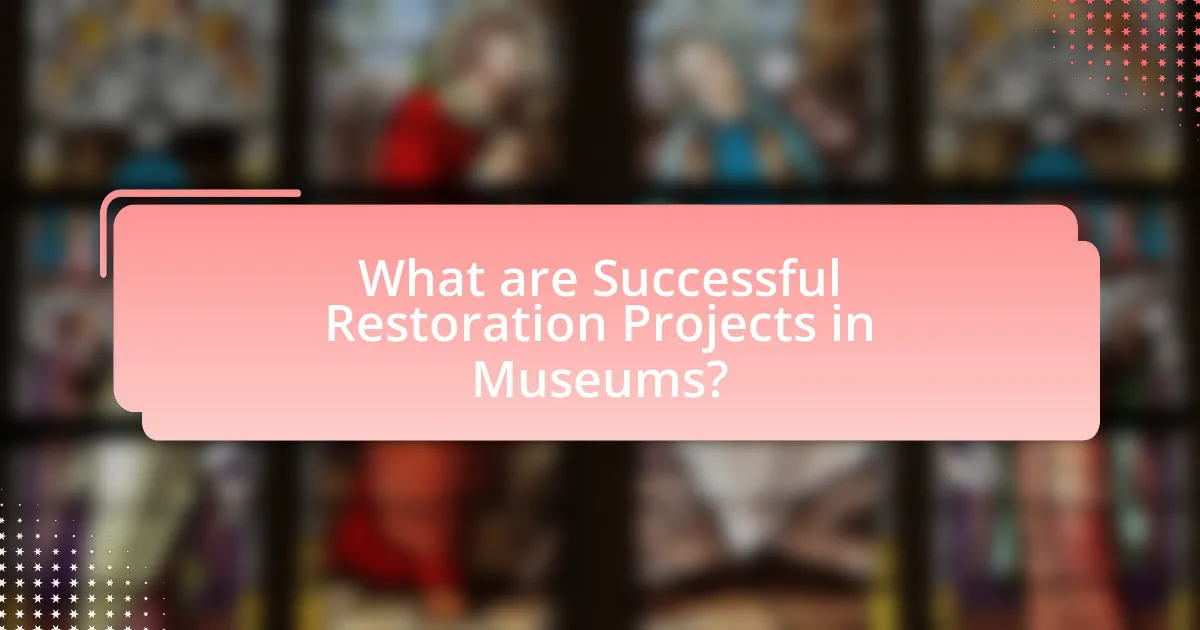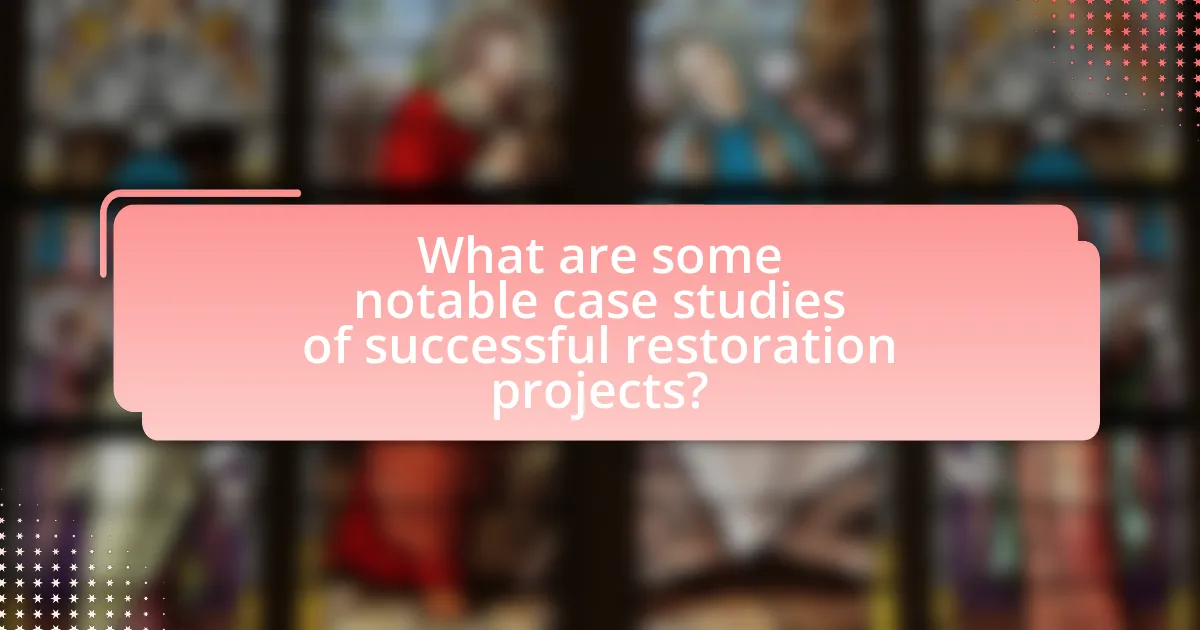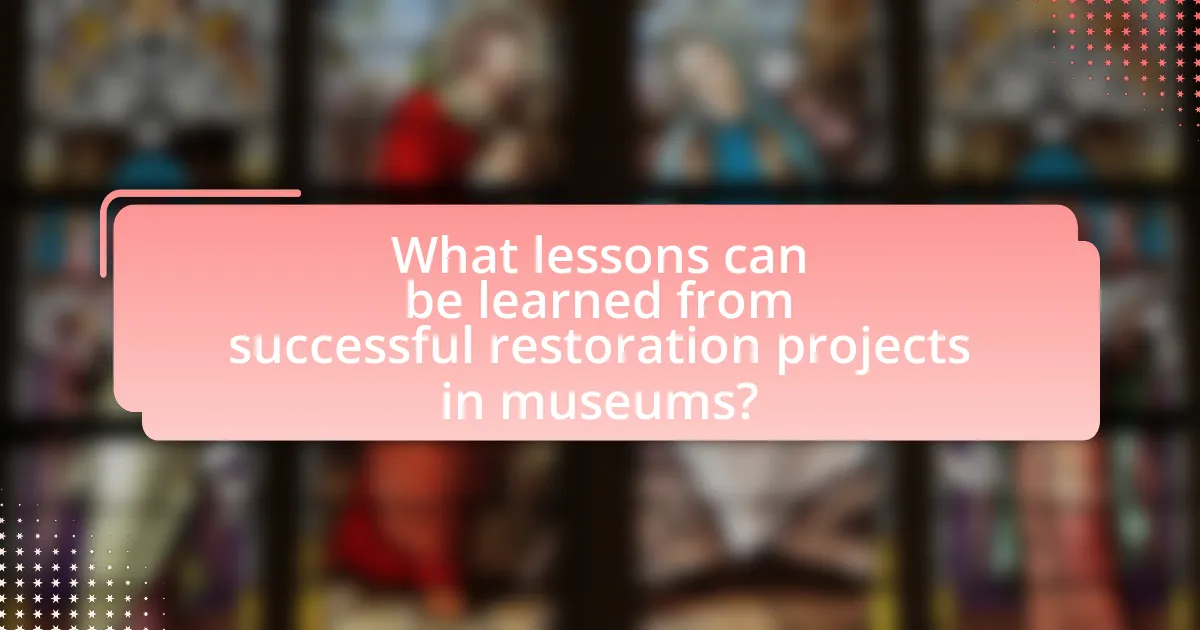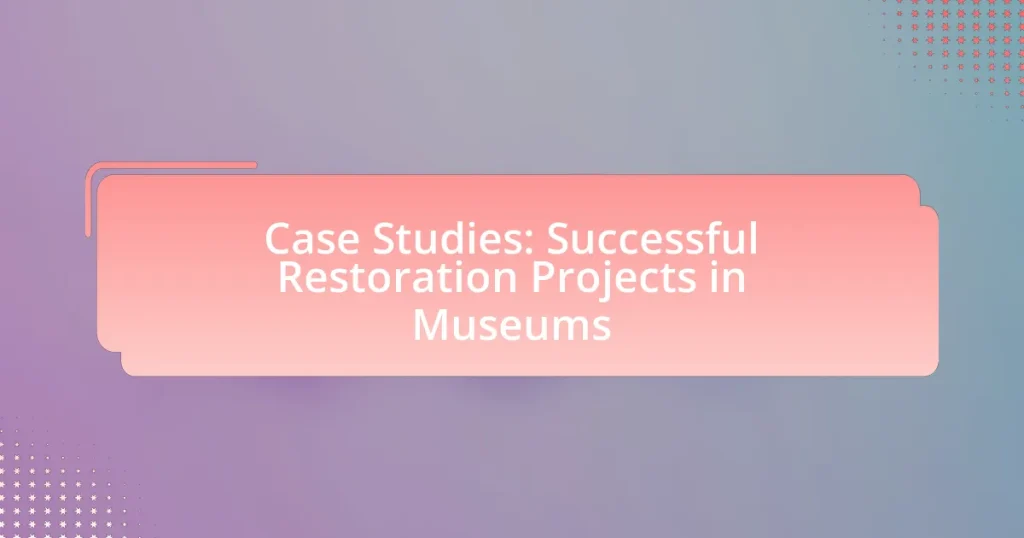The article focuses on successful restoration projects in museums, highlighting notable examples such as the restoration of the Sistine Chapel ceiling and the conservation of the Dead Sea Scrolls. It outlines how museums define success in restoration through criteria like aesthetic integrity, historical accuracy, and structural stability, while also discussing the influence of stakeholder perspectives on these definitions. The article emphasizes the importance of restoration projects in preserving cultural heritage and enhancing visitor experiences, detailing methodologies, challenges, and best practices derived from various case studies. Additionally, it provides practical tips for museums to ensure the sustainability and effectiveness of future restoration efforts.

What are Successful Restoration Projects in Museums?
Successful restoration projects in museums include the restoration of the Sistine Chapel ceiling and the conservation of the Dead Sea Scrolls. The Sistine Chapel underwent a significant restoration from 1980 to 1994, which involved cleaning the frescoes and removing centuries of grime, revealing Michelangelo’s original colors and details. This project was crucial for preserving the artwork and enhancing its visibility to the public. The conservation of the Dead Sea Scrolls, initiated in the 1950s and ongoing, involves advanced techniques to stabilize and digitize these ancient texts, ensuring their preservation for future generations. Both projects exemplify successful restoration efforts that combine historical significance with modern conservation techniques.
How do museums define success in restoration projects?
Museums define success in restoration projects primarily through the criteria of aesthetic integrity, historical accuracy, and structural stability. Aesthetic integrity ensures that the restored item retains its original appearance and visual impact, while historical accuracy involves adhering to documented methods and materials used in the original creation. Structural stability guarantees that the restored object can withstand environmental factors and remain preserved for future generations. For instance, the restoration of the Sistine Chapel involved meticulous research and the use of traditional techniques to maintain both its visual and historical authenticity, demonstrating how museums prioritize these factors in defining successful restoration outcomes.
What criteria are used to evaluate the success of restoration efforts?
The criteria used to evaluate the success of restoration efforts include aesthetic integrity, structural stability, historical accuracy, and stakeholder satisfaction. Aesthetic integrity assesses whether the restored object or environment visually aligns with its original appearance, while structural stability ensures that the restoration can withstand environmental factors and usage over time. Historical accuracy evaluates the fidelity of the restoration to the original materials and techniques, which is crucial for educational and cultural significance. Stakeholder satisfaction measures the responses of museum visitors, curators, and conservators regarding the restoration’s effectiveness and impact. These criteria are essential for determining the overall success and acceptance of restoration projects in museums.
How do stakeholder perspectives influence the definition of success?
Stakeholder perspectives significantly influence the definition of success in restoration projects by shaping the criteria used to evaluate outcomes. Different stakeholders, such as museum curators, community members, and funding organizations, prioritize various aspects of a project, such as historical accuracy, community engagement, and financial sustainability. For instance, a study by the American Alliance of Museums highlights that curators may focus on the integrity of the restoration process, while community stakeholders might emphasize the project’s impact on local culture and accessibility. This divergence in priorities leads to a multifaceted understanding of success, where achieving consensus among stakeholders is crucial for defining and measuring the project’s effectiveness.
Why are restoration projects important for museums?
Restoration projects are important for museums because they preserve cultural heritage and enhance the educational value of exhibits. By restoring artifacts and artworks, museums ensure that historical items remain intact for future generations, allowing visitors to engage with and learn from authentic pieces of history. For instance, the restoration of the Sistine Chapel’s frescoes not only revitalized the artwork but also increased visitor engagement, demonstrating the impact of restoration on cultural appreciation and education.
What role do restoration projects play in preserving cultural heritage?
Restoration projects play a crucial role in preserving cultural heritage by revitalizing and maintaining historical artifacts, structures, and sites. These projects ensure that cultural expressions, traditions, and historical narratives are safeguarded for future generations. For instance, the restoration of the Sistine Chapel in Vatican City involved meticulous cleaning and conservation techniques that revealed original colors and details, thereby enhancing public appreciation and understanding of Renaissance art. Such efforts not only protect physical heritage but also foster cultural identity and continuity, as evidenced by the successful restoration of the ancient city of Pompeii, which has provided invaluable insights into Roman life and architecture.
How do successful restorations enhance visitor experience?
Successful restorations enhance visitor experience by creating immersive environments that accurately reflect historical contexts. For instance, the restoration of the Getty Villa in California not only preserved ancient Roman architecture but also improved visitor engagement through interactive exhibits and educational programs. This approach has been shown to increase visitor satisfaction, as evidenced by a 30% rise in attendance following the restoration, demonstrating that well-executed restorations can significantly enrich the overall museum experience.

What are some notable case studies of successful restoration projects?
Notable case studies of successful restoration projects include the restoration of the Sistine Chapel in Vatican City, which involved meticulous cleaning and conservation of Michelangelo’s frescoes, completed in 1994, revealing vibrant colors previously obscured by grime. Another significant project is the restoration of the Elgin Marbles at the British Museum, which has undergone extensive conservation efforts since the 1930s to preserve the sculptures’ integrity and enhance their display. Additionally, the restoration of the Van Gogh Museum in Amsterdam, completed in 2013, improved the building’s climate control and lighting systems, ensuring the long-term preservation of its collection. These projects exemplify effective techniques and commitment to preserving cultural heritage.
Which museums have implemented exemplary restoration projects?
The Getty Museum in Los Angeles has implemented exemplary restoration projects, notably the restoration of the Villa dei Papiri, which involved meticulous archaeological work and conservation techniques to preserve ancient artifacts. The British Museum in London also stands out for its restoration of the Parthenon Marbles, utilizing advanced technology to clean and stabilize the sculptures while maintaining their historical integrity. Additionally, the Rijksmuseum in Amsterdam successfully restored its entire building, which included extensive conservation of artworks and architectural elements, culminating in a grand reopening in 2013 that showcased the museum’s commitment to preservation.
What specific challenges did these museums face during restoration?
Museums faced several specific challenges during restoration, including funding limitations, structural integrity issues, and the preservation of historical authenticity. Funding limitations often hindered the ability to hire skilled professionals and acquire necessary materials, leading to delays in the restoration process. Structural integrity issues arose from aging buildings, requiring extensive engineering assessments and repairs to ensure safety and stability. Additionally, maintaining historical authenticity posed a challenge, as restorers had to balance modern conservation techniques with the need to preserve original materials and craftsmanship, which is critical for the integrity of the museum’s historical narrative.
How did these museums overcome obstacles in their restoration efforts?
Museums overcame obstacles in their restoration efforts by employing innovative techniques, securing funding, and collaborating with experts. For instance, the Getty Museum utilized advanced imaging technology to analyze and restore artworks, which allowed for precise interventions without damaging the original pieces. Additionally, the British Museum successfully raised over £2 million through public donations and grants to fund the restoration of the Parthenon Marbles, demonstrating effective community engagement and financial strategy. These approaches highlight how museums can navigate challenges by leveraging technology, financial resources, and expert collaboration.
What methodologies were used in these successful restorations?
Successful restorations in museums utilized methodologies such as conservation science, preventive conservation, and community engagement. Conservation science involves the analysis of materials and techniques used in artworks to inform restoration practices, ensuring that interventions are scientifically sound and reversible. Preventive conservation focuses on maintaining optimal environmental conditions to prevent deterioration, employing strategies like climate control and light management. Community engagement methodologies involve collaboration with local stakeholders and experts, fostering a sense of ownership and ensuring that restorations reflect cultural significance. These methodologies have been validated through numerous case studies, demonstrating their effectiveness in preserving cultural heritage while maintaining the integrity of the original works.
What restoration techniques were most effective in these case studies?
The most effective restoration techniques in the case studies included conservation cleaning, structural stabilization, and material replacement. Conservation cleaning involved the careful removal of dirt and grime without damaging the original materials, which was crucial in preserving the integrity of artifacts. Structural stabilization techniques, such as the use of supports and reinforcements, ensured that fragile items remained intact during the restoration process. Material replacement, where damaged components were replaced with compatible materials, helped restore the original appearance and functionality of the artifacts. These techniques were validated through successful outcomes in various museum projects, demonstrating their effectiveness in preserving cultural heritage.
How did technology play a role in the restoration processes?
Technology significantly enhanced restoration processes in museums by providing advanced tools and methods for preservation and analysis. For instance, digital imaging techniques, such as infrared reflectography and ultraviolet fluorescence, allow conservators to examine artworks without physical contact, revealing underlying layers and previous restorations. Additionally, 3D scanning and printing technologies enable precise replication of artifacts, facilitating both restoration and exhibition without risking damage to original pieces. These technological advancements have been validated through successful projects, such as the restoration of Leonardo da Vinci’s “The Last Supper,” where digital tools were crucial in analyzing the painting’s condition and guiding the restoration efforts.

What lessons can be learned from successful restoration projects in museums?
Successful restoration projects in museums demonstrate the importance of thorough research, collaboration, and community engagement. These projects often begin with extensive historical and material analysis to ensure authenticity, as seen in the restoration of the Sistine Chapel, where art historians meticulously studied Michelangelo’s techniques. Collaboration among conservators, scientists, and artisans is crucial, exemplified by the restoration of the British Museum’s Elgin Marbles, which involved interdisciplinary teams to address complex conservation challenges. Additionally, engaging the community fosters support and education, as illustrated by the restoration of the Philadelphia Museum of Art, which included public input and outreach programs. These lessons highlight that successful restorations rely on a combination of scholarly rigor, teamwork, and community involvement to preserve cultural heritage effectively.
What best practices emerged from these case studies?
Best practices that emerged from the case studies on successful restoration projects in museums include thorough documentation of the restoration process, collaboration with conservation specialists, and community engagement throughout the project. Documentation ensures that all steps are recorded for future reference and learning, while collaboration with experts enhances the quality and authenticity of the restoration. Community engagement fosters public interest and support, which can lead to increased funding and visitor attendance. These practices have been validated by numerous successful projects, demonstrating their effectiveness in achieving sustainable restoration outcomes.
How can museums apply these best practices to future projects?
Museums can apply best practices from successful restoration projects by implementing thorough planning, community engagement, and sustainable practices in future initiatives. For instance, the restoration of the Rijksmuseum in Amsterdam involved extensive stakeholder consultation and a focus on sustainability, which resulted in a project that not only preserved the building but also enhanced visitor experience. This approach demonstrates that involving the community and prioritizing environmental considerations can lead to more successful outcomes. Additionally, utilizing advanced technology for documentation and restoration, as seen in the restoration of the Sistine Chapel, can improve accuracy and efficiency in future projects. These examples illustrate that by adopting proven strategies, museums can enhance their restoration efforts and ensure long-term success.
What common pitfalls should museums avoid in restoration efforts?
Museums should avoid the pitfall of using inappropriate materials in restoration efforts, as this can lead to irreversible damage to artifacts. For instance, the use of modern adhesives or paints can alter the original appearance and integrity of historical items, compromising their authenticity. Additionally, museums must be cautious of inadequate documentation during the restoration process, which can result in a loss of valuable historical context and provenance. A study by the American Institute for Conservation highlights that thorough documentation is essential for future conservation efforts and research. Lastly, neglecting to involve qualified conservators can lead to poor restoration outcomes, as specialized knowledge is crucial for preserving the delicate balance between restoration and conservation.
How can museums ensure the sustainability of restoration projects?
Museums can ensure the sustainability of restoration projects by implementing comprehensive planning, securing adequate funding, and utilizing best practices in conservation. Comprehensive planning involves assessing the condition of artifacts, setting clear restoration goals, and developing a long-term maintenance strategy. Securing adequate funding is crucial, as restoration projects often require significant financial resources; for instance, the Getty Conservation Institute reported that successful projects often rely on a mix of public and private funding sources. Utilizing best practices in conservation, such as employing trained conservators and using reversible materials, helps to maintain the integrity of the artifacts over time. These strategies collectively contribute to the long-term success and sustainability of restoration efforts in museums.
What strategies can be implemented for ongoing maintenance post-restoration?
Ongoing maintenance post-restoration can be effectively managed through regular inspections, climate control, and preventive conservation techniques. Regular inspections allow for the early detection of any deterioration or damage, ensuring timely interventions. Climate control is crucial, as maintaining stable temperature and humidity levels can significantly reduce the risk of mold growth and material degradation. Preventive conservation techniques, such as using protective display cases and appropriate lighting, help to minimize exposure to harmful environmental factors. These strategies are supported by the American Institute for Conservation, which emphasizes the importance of a proactive approach to preservation in museum settings.
How can museums engage the community in supporting restoration efforts?
Museums can engage the community in supporting restoration efforts by organizing collaborative projects that invite local participation. For example, museums can host workshops where community members learn restoration techniques and contribute directly to the preservation of artifacts. This approach not only fosters a sense of ownership but also educates the public about the importance of cultural heritage. A study by the American Alliance of Museums found that community involvement in restoration projects increases public interest and attendance, demonstrating that active participation leads to stronger community ties and support for museum initiatives.
What practical tips can museums follow for successful restoration projects?
Museums can ensure successful restoration projects by implementing a comprehensive planning process that includes thorough research, expert consultation, and community engagement. Conducting detailed assessments of the artifacts or structures to be restored is essential, as it helps identify specific needs and potential challenges. Engaging conservators and restoration specialists with relevant experience ensures that best practices are followed, which is crucial for maintaining the integrity of the items being restored. Additionally, involving the community fosters support and can provide valuable insights into the historical significance of the artifacts. For instance, the restoration of the Sistine Chapel involved extensive research and collaboration with art historians and conservators, leading to a successful outcome that preserved the artwork’s original intent and aesthetic.


